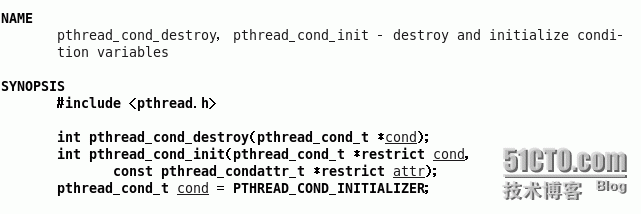关于Flash中的ASO文件
2010-03-17 16:22
176 查看
一、生产消费模型:我们可以用条件变量来实现线程之间的同步,利用一个生产消费模型具体的实现同步。生产消费模型可以简单地称为3,2,1模型(即3种关系,2个对象,1个场所),同时还需注意以下3点:
1、生产者和消费者是同步互斥关系;
2、生产者和生产者是互斥关系;
3、消费者和消费者是互斥关系。
二、条件变量的理解:线程A需要等某个条件成才能继续往下执,现在这个条件不成,线程A就阻塞等待,线程B在执过程中使这个条件成了,就唤醒线程A继续执。 在pthread库中通过条件变量(Condition Variable)来阻塞等待个条件,或者唤醒等待这个条件的线程。
相关函数有:

1、初始化:thread_cond_init函数初始化个Condition Variable,attr参数 为NULL则表缺省属性,pthread_cond_destroy函数销毁个Condition Variable。如果ConditionVariable是静态分配的,也可以宏定义PTHEAD_COND_INITIALIZER初始化,相当于pthread_cond_init函数初始化并且attr参数为NULL。

2、阻塞等待线程:个线程可以调 pthread_cond_wait在个Condition Variable上阻塞等待,这个函数做以下三步操作:
1). 释放Mutex
2). 阻塞等待
3). 当被唤醒时,重新获得Mutex并返回
个线程可以调pthread_cond_signal唤醒在某个Condition Variable上等待的另个线程,也可以调pthread_cond_broadcast唤醒在这个Condition Variable上等待的所有线程。
代码实现:
创建生产者使用的是链表,整个过程是生产者从链表表尾生产数据,消费者从表头获取数据。并且是多生产者多消费者模型。

1、生产者和消费者是同步互斥关系;
2、生产者和生产者是互斥关系;
3、消费者和消费者是互斥关系。
二、条件变量的理解:线程A需要等某个条件成才能继续往下执,现在这个条件不成,线程A就阻塞等待,线程B在执过程中使这个条件成了,就唤醒线程A继续执。 在pthread库中通过条件变量(Condition Variable)来阻塞等待个条件,或者唤醒等待这个条件的线程。
相关函数有:

1、初始化:thread_cond_init函数初始化个Condition Variable,attr参数 为NULL则表缺省属性,pthread_cond_destroy函数销毁个Condition Variable。如果ConditionVariable是静态分配的,也可以宏定义PTHEAD_COND_INITIALIZER初始化,相当于pthread_cond_init函数初始化并且attr参数为NULL。

2、阻塞等待线程:个线程可以调 pthread_cond_wait在个Condition Variable上阻塞等待,这个函数做以下三步操作:
1). 释放Mutex
2). 阻塞等待
3). 当被唤醒时,重新获得Mutex并返回
个线程可以调pthread_cond_signal唤醒在某个Condition Variable上等待的另个线程,也可以调pthread_cond_broadcast唤醒在这个Condition Variable上等待的所有线程。
代码实现:
创建生产者使用的是链表,整个过程是生产者从链表表尾生产数据,消费者从表头获取数据。并且是多生产者多消费者模型。
#include<stdio.h>
#include<stdlib.h>
#include<pthread.h>
typedef struct list
{
int _data;
struct list* _next;
}product_list;
product_list* head=NULL;
static pthread_mutex_t lock=PTHREAD_MUTEX_INITIALIZER;
static pthread_cond_t need_product=PTHREAD_COND_INITIALIZER;
product_list* createNode(int data)
{
product_list* tmp=malloc(sizeof(product_list));
tmp->_data=data;
tmp->_next=NULL;
return tmp;
}
void InitList(product_list** phead)
{
*phead=createNode(0);
}
int Push(product_list* phead,int data)
{
product_list* tail=phead;
while(tail->_next!=NULL)
{
tail=tail->_next;
}
product_list* new=createNode(data);
tail->_next=new;
return new->_data;
}
int Pop(product_list* phead)
{
product_list* tmp=phead->_next;
phead->_next=phead->_next->_next;
phead=phead->_next;
tmp->_next=NULL;
int val=tmp->_data;
free(tmp);
tmp=NULL;
return val;
}
void* product(void* arg)
{
int i=0;
for(;i<10;i++)
{
sleep(3);
pthread_mutex_lock(&lock);
int val=Push(head,i);
pthread_mutex_unlock(&lock);
printf("product success!the data is:%d\n",val);
pthread_cond_signal(&need_product);
}
}
void* consumer(void* arg)
{
while(1)
{
pthread_mutex_lock(&lock);
while(head->_next==NULL)
{
pthread_cond_wait(&need_product,&lock);
}
int val=Pop(head);
pthread_mutex_unlock(&lock);
printf("consumer data is:%d\n",val);
}
return NULL;
}
int main()
{
InitList(&head);
pthread_t product1;
pthread_t product2;
pthread_t product3;
pthread_t consumer1;
pthread_t consumer2;
pthread_t consumer3;
pthread_create(&product1,NULL,product,NULL);
pthread_create(&product2,NULL,product,NULL);
pthread_create(&product3,NULL,product,NULL);
pthread_create(&consumer1,NULL,consumer,NULL);
pthread_create(&consumer2,NULL,consumer,NULL);
pthread_create(&consumer3,NULL,consumer,NULL);
pthread_join(product1,NULL);
pthread_join(product2,NULL);
pthread_join(product3,NULL);
pthread_join(consumer1,NULL);
pthread_join(consumer2,NULL);
pthread_join(consumer3,NULL);
return 0;
}运行结果如下:
相关文章推荐
- [Flash开发笔记] 关于Flash中的ASO文件
- [Flash开发笔记] 关于Flash中的ASO文件
- [VB.net]关于exe格式flash文件的播放器的剥除(11.01)(exe2swf格式转换器)
- 关于嵌入式Linux系统flash分区设计及文件系统格式选择的一些浅见
- [VB.net]关于exe格式flash文件的播放器的剥除(11.02)(exe2swf格式转换器)
- 关于linux下的嵌入式文件系统以及flash文件系统选择 分类: arm-linux-Ubuntu HI3531 2013-12-25 15:26 530人阅读 评论(0) 收藏
- 关于linux下的嵌入式文件系统以及flash文件系统选择
- 【转载】关于Flash文件在Vegas中的编辑
- 关于嵌入式Linux系统flash分区设计及文件系统格式选择的一些浅见
- 关于linux下的嵌入式文件系统以及flash文件系统选择
- 关于linux下的嵌入式文件系统以及flash文件系统选择(转)
- 关于linux下的嵌入式文件系统以及flash文件系统选择
- [VB.net]关于exe格式flash文件的播放器的剥除(11.12)(exe2swf格式转换器)(更新华为网盘)
- 关于linux下的嵌入式文件系统以及flash文件系统选择
- 关于linux下的嵌入式文件系统以及flash文件系统选择
- 关于STM32F4将数据或文件写入W28Q128(SPI_FLASH)中的方法(精)
- flash 安全服务策略文件 关于843端口
- 关于 flash (jw player)不能处理 flv视频 中文名文件 或者 中文路径 的 解决方案
- 关于flash的多文件上传的http头
- 关于FlashPrinter转换文档未输出swf文件问题
